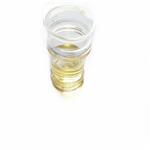Description
3-Heptanone has a powerful, green, fatty, fruity odor and a melon,
banana flavor. Prepared from n-hept-2-one by hydration.
Chemical Properties
3-Heptanone has a fruity, green, fatty, sweet, ethereal, powerful odor and a melon, banana favor.
Chemical Properties
colourless liquid
Chemical Properties
Ethyl butyl ketone is a colorless liquid with a
powerful, fruity odor.
Occurrence
Reported found in apple juice, banana, peach, pear, spearmint oil, Parmesan cheese, butter, cream, lean fsh, fsh oil, roasted chicken, cooked beef, coffee, peanut oil, pecan, yellow passion fruit, plumcot, beans, plum brandy, sesame seed, mango and cooked shrimps
Uses
Solvent and intermediate for organic
materials
Uses
3-Heptanone is a seven carbon ketone with a "fruity" scent. It is often used as a perfume/fragrance industry and can also be applied as a solvent.
Uses
Solvent mix for air-dried and baked finishes,
for polyvinyl and nitrocellulose resins.
Uses
Ethyl butyl ketone is used as a solvent fornitrocellulose and polyvinyl resins, and as anintermediate in organic synthesis.
Production Methods
EnBK is produced either by catalytic dehydrogenation of
3-heptanol or by hydrogenation of the mixed alcohol condensation
product of propionaldehyde and methyl ethyl
ketone. Commercial samples can be 95% pure.
Preparation
From n-hept-2-one by hydration.
Definition
ChEBI: A dialkyl ketone with butyl and ethyl as the two alkyl groups.
Aroma threshold values
Detection: 7 5 to 160 ppb.
Taste threshold values
Taste characteristics at 50 ppm: ketonic, with a cheese-like creamy character.
General Description
Colorless odorless liquid with a mild fruity odor. Flash point 140°F.
Air & Water Reactions
Flammable.
Reactivity Profile
3-Heptanone is reactive with many acids and bases liberating heat and flammable gases (e.g., H2). The amount of heat may be sufficient to start a fire in the unreacted portion. Reacts with reducing agents such as hydrides, alkali metals, and nitrides to produce flammable gas (H2) and heat. Incompatible with isocyanates, aldehydes, cyanides, peroxides, and anhydrides. May react violently with aldehydes, HNO3, HNO3 + H2O2, and HClO4. Irritating vapors and toxic gases may be formed when involved in fire [USCG, 1999].
Hazard
Moderate fire risk.
Health Hazard
Short term exposure can cause irritation of eyes, nose, throat and lungs. High concentrations may cause headache, dizziness or unconsciousness.
Health Hazard
Inhalation of the vapor of ethyl butyl ketonecan cause irritation to the eyes, skin, andmucous membranes. Its irritation effect wasmild on rabbit skin and eyes. Prolonged skincontact can cause dermatitis. Exposure to4000 ppm for 4 hours proved fatal to rats.Ingestion can cause headache and narcosis,and in large doses coma can occur.
LD50 value, oral (rats): 2760 mg/kg.
Fire Hazard
Special Hazards of Combustion Products: Irritating vapors and toxic gases, such as carbon dioxide and carbon monoxide, may be formed when involved in fire.
Safety Profile
Moderately toxic by
ingestion and inhalation. A skin and eye
irritant. A flammable liquid. Can react with
oxidizing materials. To fight fire, use foam,
Co2, dry chemical. See also KETONES.
Potential Exposure
Ethyl butyl ketone is used as a solvent
and as an intermediate in organic synthesis. It is a solvent
for vinyl and nitrocellulose resins. It is used in food
flavoring
First aid
If this chemical gets into the eyes, remove anycontact lenses at once and irrigate immediately for at least15 min, occasionally lifting upper and lower lids. Seek medical attention immediately. If this chemical contacts theskin, remove contaminated clothing and wash immediatelywith soap and water. Seek medical attention immediately. Ifthis chemical has been inhaled, remove from exposure,begin rescue breathing (using universal precautions, including resuscitation mask) if breathing has stopped and CPR ifheart action has stopped. Transfer promptly to a medicalfacility. When this chemical has been swallowed, get medical attention. Give large quantities of water and inducevomiting. Do not make an unconscious person vomit
Environmental Fate
Chemical/Physical. 3-Heptanone will not hydrolyze because it has no hydrolyzable functional
group.
Solubility in organics
Insoluble in water, soluble in alcohol, miscible with oils.
storage
Color Code—Red: Flammability Hazard: Store ina flammable liquid storage area or approved cabinet awayfrom ignition sources and corrosive and reactive materials.Prior to working with this chemical you should be trained onits proper handling and storage. Ethyl butyl ketone must bestored to avoid contact with oxidizers, such as peroxides,chlorates, perchlorates, permanganates, and nitrates, becauseviolent reactions occur. Store in tightly closed containers ina cool, well-ventilated area away from heat. Sources of ignition, such as smoking and open flames, are prohibited whereethyl butyl ketone is used, handled, or stored in a mannerthat could create a potential fire or explosion hazard
Shipping
UN1224 Ketones, liquid, n.o.s., Hazard Class: 3;
Labels: 3-Flammable liquid, Technical Name Required.
Incompatibilities
May form explosive mixture with air.
Violent reaction with strong oxidizers, acetaldehyde, perchloric acid. Attacks some plastics, rubber and coatings
Waste Disposal
Dissolve or mix the material
with a combustible solvent and burn in a chemical incinerator equipped with an afterburner and scrubber. All federal,
state, and local environmental regulations must be observed






